Women Farmers and Agricultural Innovation: Marital Status and Normative Expectations in Rural Ethiopia
Abstract
1. Introduction
1.1. Literature Review
1.1.1. Gender and the Adoption of Improved Maize and Wheat Varieties in Ethiopia
1.1.2. Female Headedness in Ethiopia
1.1.3. Perceptions of Women as Farmers in Ethiopia
1.1.4. Gendered Access to Resources: Land, Labor, and Finance in Rural Ethiopia
2. Materials and Methods
2.1. Sampling and Data Collection
2.2. The Study Communities
3. Results
3.1. Women’s Agricultural Innovation Experiences
3.2. Women’s Access to Resources
3.2.1. Gendered Access to Land
3.2.2. Gendered Access to Labor
3.2.3. Gendered Access to Credit
3.3. Women’s Agency
3.3.1. Women’s Current Agency
3.3.2. Trends in Women’s Agency over Time
3.3.3. Associations between Gender-Based Violence, Agency, and Capacity to Innovate
3.4. Women’s Achievements (Outcomes)
4. Discussion
5. Conclusions
Author Contributions
Funding
Acknowledgments
Conflicts of Interest
References
- World Economic Forum. Global Gender Gap Report 2020; World Economic Forum: Geneva, Switzerland, 2019. [Google Scholar]
- Teshome, A. How the Gender Equality Strategy for Ethiopia’s Agriculture Sector Can Improve Outcomes for All; Technical Brief for the Agriculture Knowledge, Learning, Documentation and Policy (AKLDP) Project: Addis Ababa, Ethiopia, July 2018. [Google Scholar]
- Mulema, A.A.; Jogo, W.; Damtew, E.; Mekonnen, K.; Thorne, P. Women farmers’ participation in the agricultural research process: Implications for agricultural sustainability in Ethiopia. Int. J. Agric. Sustain. 2019, 17, 127–145. [Google Scholar] [CrossRef]
- Drucza, K.; Rodriguez, M.d.C. Feminist Policy Analysis Implications for the Agricultural Sector in Ethiopia; International Maize and Wheat Improvement Center: Addis Ababa, Ethiopia, 2018. [Google Scholar]
- Agarwal, B. Gender equality, food security and the sustainable development goals. Curr. Opin. Environ. Sustain. 2018, 34, 26–32. [Google Scholar] [CrossRef]
- Food and Agriculture Organization of the United Nations. Women in Agriculture: Closing the Gender Gap for Development; State of Food and Agriculture 2010-11; Food and Agriculture Organization of the United Nations: Rome, Italy, 2011. [Google Scholar]
- The World Bank; Food and Agriculture Organization of the United Nations; The International Fund for Agricultural Development. Gender in Agriculture Sourcebook; Agriculture and Rural Development, World Bank: Washington, DC, USA, 2009. [Google Scholar]
- World Bank; ONE Campaign. Levelling the field: Improving opportunities for women farmers in Africa; World Bank: Washington, DC, USA, 2014. [Google Scholar]
- United Nations. Sustainable Development Goals: Goal 2 Zero Hunger. Available online: https://www.un.org/sustainabledevelopment/hunger/ (accessed on 21 September 2020).
- Food and Agriculture Organization of the United Nations. Sustainable Development Goals Indicator 5.a.2. Available online: https://www.un.org/sustainabledevelopment/gender-equality/ (accessed on 21 September 2020).
- Omilola, B.; Robele, S. The Central Position of Agriculture within the 2030 Agenda for Sustainable Development; International Food Policy Research Institute: Washington, DC, USA, 2017. [Google Scholar]
- Kabeer, N. ‘Leaving No One Behind’: The Challenge of Intersecting Inequalities; World Social Science Report 2016; UNESCO and the ISSC: Paris, France, 2016. [Google Scholar]
- Gebre, G.G.; Isoda, H.; Rahut, D.B.; Amekawa, Y.; Nomura, H. Gender differences in the adoption of agricultural technology: The case of improved maize varieties in Southern Ethiopia. Womens. Stud. Int. Forum 2019, 76, 1–11. [Google Scholar] [CrossRef] [PubMed]
- Quisumbing, A.R.; Kumar, N. Land Rights Knowledge and Conservation in Rural Ethiopia: Mind the Gender Gap; IFPRI Discussion Paper 01386; International Food Policy Research Institute: Washington, DC, USA, November 2014. [Google Scholar]
- Badstue, L.; Elias, M.; Kommerell, V.; Petesch, P.; Prain, G.; Pyburn, R.; Umantseva, A. Making room for manoeuvre: Addressing gender norms to strengthen the enabling environment for agricultural innovation. Dev. Pract. 2020, 30, 541–547. [Google Scholar] [CrossRef] [PubMed]
- Kabeer, N. Resources, agency, achievements: Reflections on the measurement of women’s empowerment. Dev. Chang. 1999, 30, 435–464. [Google Scholar] [CrossRef]
- Tanellari, E.; Kostandini, G.; Bonabana, J. Gender impacts on adoption of new technologies: Evidence from Uganda. Afr. J. Agric. Resour. Econ. 2013, 9, 300–308. [Google Scholar] [CrossRef]
- Doss, C.R. Twenty-Five Years of Research on Women Farmers in Africa: Lessons and Implications for Agricultural Research Institutions with an Annotated Bibliography; CIMMYT Economics Program Paper No. 99-02; International Maize and Wheat Improvement Center: Mexico City, Mexico, 1999. [Google Scholar]
- Quisumbing, A.R.; Pandolfelli, L. Promising Approaches to Address the Needs of Poor Female Farmers; IFPRI Discussion Paper 00882; International Food Policy Research Institute: Washington, DC, USA, July 2009. [Google Scholar]
- Udry, C. Gender, agricultural production, and the theory of the household. J. Polit. Econ. 1996, 104, 1010–1046. [Google Scholar] [CrossRef]
- Ndiritu, S.W.; Kassie, M.; Shiferaw, B. Are there systematic gender differences in the adoption of sustainable agricultural intensification practices? Evidence from Kenya. Food Policy 2014, 49, 117–127. [Google Scholar] [CrossRef]
- Sen, A. Gender and Cooperative Conflict; Wider Working Papers 18; UNU-WIDER: Helsinki, Finland, 1987. [Google Scholar]
- Manda, J.; Mvumi, B.M. Gender relations in household grain storage management and marketing: The case of Binga District, Zimbabwe. Agric. Human Values 2010, 27, 85–103. [Google Scholar] [CrossRef][Green Version]
- Butler, J. Performative acts and gender constitution: An essay in phenomenology and feminist theory. Theatr. J. 1988, 40, 519–531. [Google Scholar] [CrossRef]
- O’Brien, C.; Gunaratna, N.S.; Gebreselassie, K.; Gitonga, Z.M.; Tsegaye, M.; De Groote, H. Gender as a cross-cutting issue in food security: The NuME project and quality protein maize in Ethiopia. World Med. Health Policy 2016, 8, 263–286. [Google Scholar] [CrossRef]
- Kassa, Y.; Kakrippai, R.S.; Legesse, B. Determinants of adoption of improved maize varieties for male headed and female headed households in West Harerghe Zone, Ethiopia. Int. J. Econ. Behav. Organ. 2013, 1, 33–38. [Google Scholar] [CrossRef]
- Tiruneh, A.; Tesfaye, T.; Mwangi, W.; Verkuijl, H. Gender Differentials in Agricultural Production and Decision-Making Among Smallholders in Ada, Lume, and Gimbichu Woredas of the Central Highlands of Ethiopia; International Maize and Wheat Improvement Center: Mexico City, Mexico, February 2001. [Google Scholar]
- Ragasa, C.; Berhane, G.; Tadesse, F.; Taffesse, A.S. Gender differences in access to extension services and agricultural productivity. J. Agric. Educ. Exten. 2012, 19, 437–468. [Google Scholar] [CrossRef]
- Nelson, K.M. Analysis of Farmer Preferences for Wheat Variety Traits in Ethiopia: A Gender-Responsive Study. Master’s Thesis, Cornell University, Ithaca, NY, USA, 2013. [Google Scholar]
- Ahmed, M.E. Poverty and Livelihood Strategies of Female-Headed Households in Rural Ethiopia: The Case of Libo Kemkem Woreda, South Gondar. Ph.D. Dissertation, Andhra University, Visakhapatnam, India, 2013. [Google Scholar]
- Farnworth, C.R.; López, D.E.; Badstue, L.; Hailemariam, M.; Abeyo, B.G. Gender and agricultural innovation in Oromia Region, Ethiopia: From innovator to tempered radical. Gend. Technol. Dev. 2018, 22, 222–245. [Google Scholar] [CrossRef] [PubMed]
- National Planning Commission. Growth and Transformation Plan II (Volume I); National Planning Commission of the Federal Democratic Republic of Ethiopia: Addis Ababa, Ethiopia, 2016. [Google Scholar]
- Aregu, L.; Bishop-Sambrook, C.; Puskur, R.; Tesema, E. Opportunities for Promoting Gender Equality in Rural Ethiopia through the Commercialization of Agriculture; Working Paper No. 18; International Livestock Research Institute: Addis Ababa, Ethiopia, 2010. [Google Scholar]
- Gella, A.; Tadele, G. Gender and farming in Ethiopia: An exploration of discourses and implications for policy and research. Ethiop. J. Soc. Sci. Humanit. 2015, 11, 1–28. [Google Scholar]
- Fafchamps, M.; Quisumbing, A.R. Control and ownership of assets within rural Ethiopian households. J. Dev. Stud. 2002, 38, 47–82. [Google Scholar] [CrossRef]
- Kumar, N.; Quisumbing, A.R. Policy reform toward gender equality in Ethiopia: Little by little the egg begins to walk. World Dev. 2015, 67, 406–423. [Google Scholar] [CrossRef]
- Miller, D.; Tolina, E.T. Land to the tiller redux: Unlocking Ethiopia’s land potential. Drake J. Agric. Law 2008, 13, 348–376. [Google Scholar]
- Mulema, A.A.; Damtew, E. Gender-Based Constraints and Opportunities to Agricultural Intensification in Ethiopia: A Systematic Review; International Livestock Research Institute: Nairobi, Kenya, August 2016. [Google Scholar]
- Holden, S.T.; Tilahun, M. Farm size and gender distribution of land: Evidence from Ethiopian land registry data. World Dev. 2020, 130, 1–16. [Google Scholar] [CrossRef]
- Muchomba, F.M. Women’s land tenure security and household human capital: Evidence from Ethiopia’s land certification. World Dev. 2017, 98, 310–324. [Google Scholar] [CrossRef] [PubMed]
- Howard, P.; Smith, E. Leaving Two Thirds out of Development: Female Headed Households and Common Property Resources in the Highlands of Tigray, Ethiopia; Food and Agriculture Organization of the United Nations: Rome, Italy, September 2006. [Google Scholar]
- Petesch, P.; Badstue, L.; Camfield, L.; Feldman, S.; Prain, G.; Kantor, P. Qualitative, comparative, and collaborative research at large scale: The GENNOVATE field methodology. J. Gend. Agric. Food Secur. 2018, 3, 28–53. [Google Scholar] [CrossRef]
- Petesch, P.; Badstue, L.; Prain, G. Gender Norms, Agency, and Innovation in Agriculture and Natural Resource Management: The Gennovate Methodology; International Maize and Wheat Improvement Center: Mexico City, Mexico, 2018. [Google Scholar]
- Alemayehu, M.; Meskele, M. Health care decision making autonomy of women from rural districts of Southern Ethiopia: A community based cross-sectional study. Int. J. Womens. Health 2017, 9, 213–221. [Google Scholar] [CrossRef] [PubMed]
- John, N.A.; Edmeades, J.; Murithi, L.; Barre, I. Child marriage and relationship quality in Ethiopia. Cult. Heal. Sex. 2019, 21, 853–866. [Google Scholar] [CrossRef] [PubMed]
- Chuta, N. Young Women’s Household Bargaining Power in Marriage and Parenthood in Ethiopia; Working Paper 166; Young Lives, Oxford Department of International Development: Oxford, UK, February 2017. [Google Scholar]
- Kandiyoti, D. Bargaining with patriarchy. Gend. Soc. 1988, 2, 274–290. [Google Scholar] [CrossRef]
- Shiferaw, N. Transformative Household Methodology, Ethiopia: Gender, Targeting and Social Inclusion; International Fund for Agricultural Development: Rome, Italy, October 2014. [Google Scholar]
- Farnworth, C.; Sundell, M.F.; Nzioki, A.; Shivutse, V.; Davis, M. Transforming Gender Relations in Agriculture in Sub-Saharan Africa; Swedish International Agricultural Network Initiative (SIANI): Stockholm, Sweden, 2013. [Google Scholar]
- Farnworth, C.R.; Stirling, C.M.; Chinyophiro, A.; Namakhoma, A.; Morahan, R. Exploring the potential of household methodologies to strengthen gender equality and improve smallholder livelihoods: Research in Malawi in maize-based systems. J. Arid Environ. 2018, 149, 53–61. [Google Scholar] [CrossRef]
- Reemer, T.; Makanza, M. Gender Action Learning System: Practical Guide for Transforming Gender and Unequal Power Relations in Value Chains; Oxfam Novib: The Hague, The Netherlands, 2014. [Google Scholar]
- United Nations Development Programme. Upscaling Community Conversations in Ethiopia: Unleashing Capacities of Communities for the HIV/AIDS Response; United Nations Development Programme: Addis Ababa, Ethiopia, 2004. [Google Scholar]
- Farnworth, C.R.; Colverson, K.E. Building a gender-transformative extension and advisory facilitation system in Sub-Saharan Africa. J. Gend. Agric. Food Secur. 2015, 1, 20–39. [Google Scholar] [CrossRef]
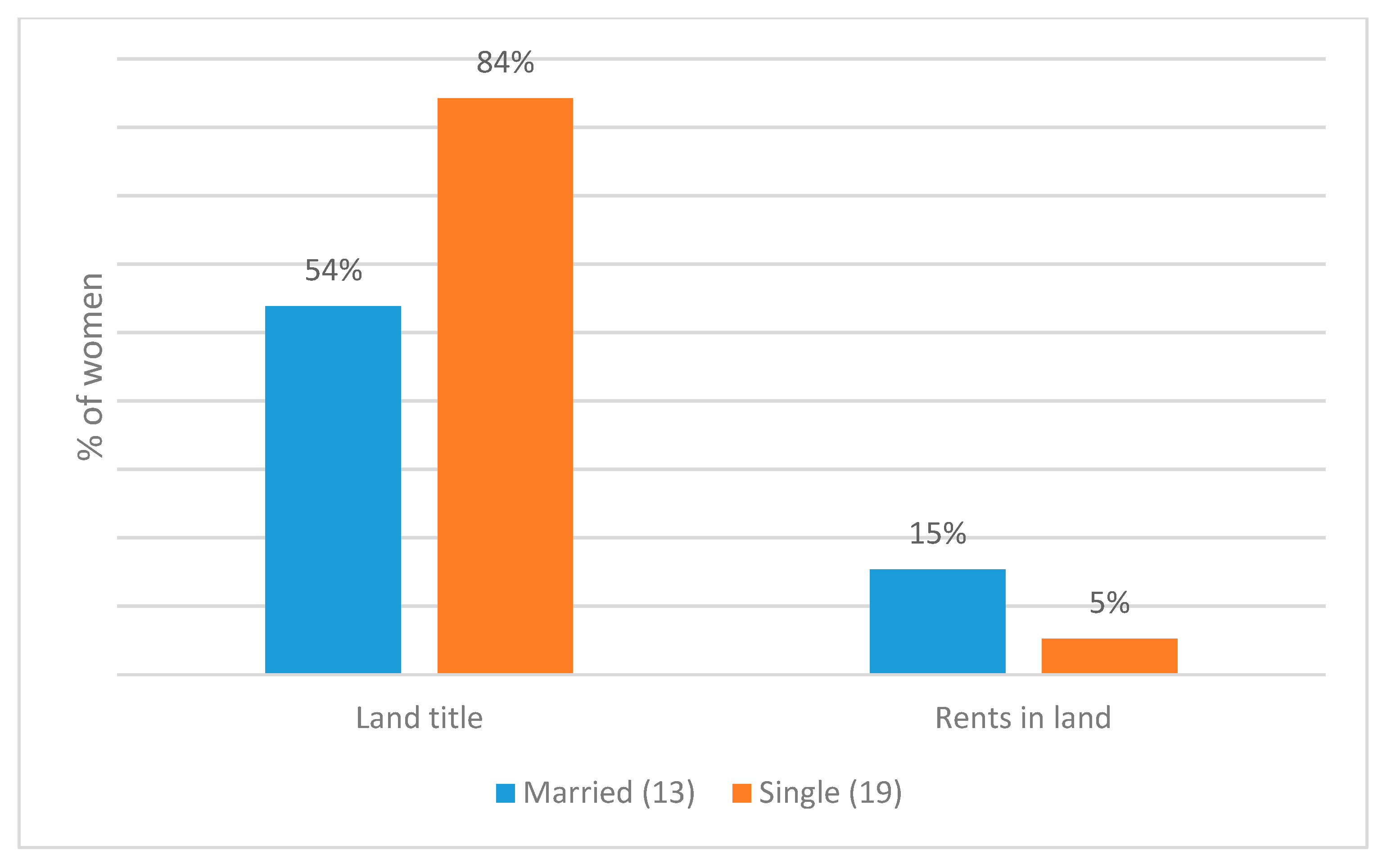
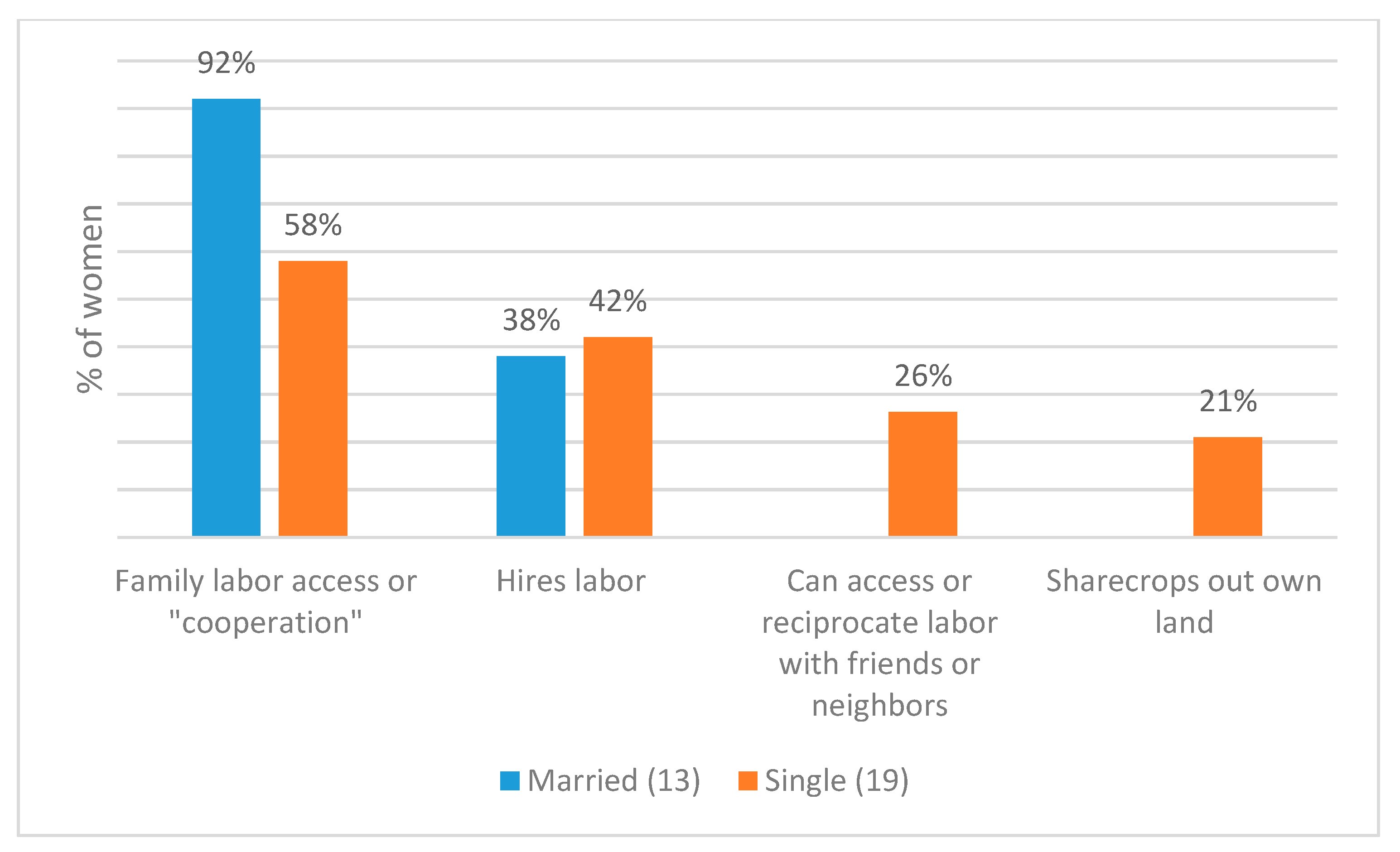
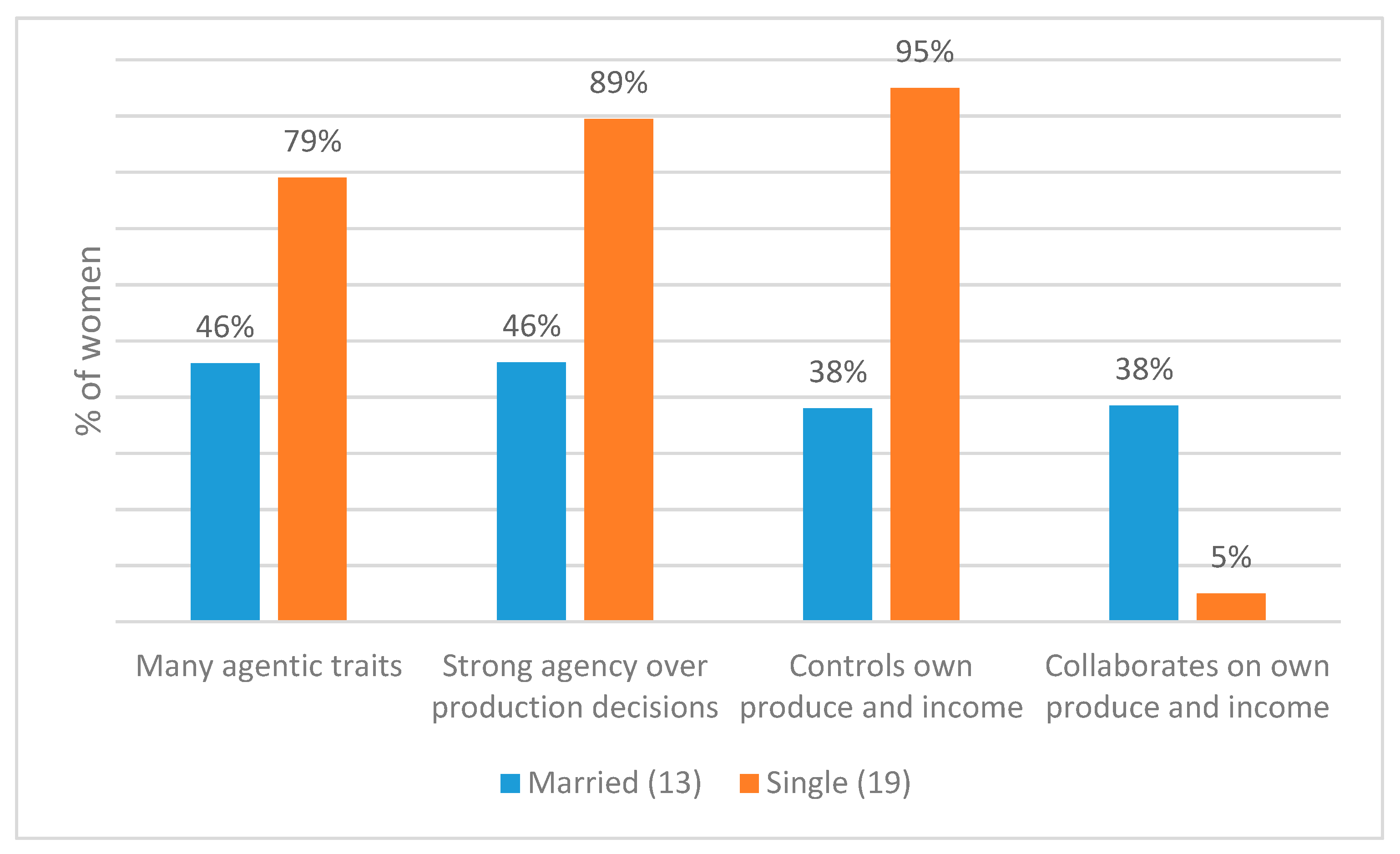
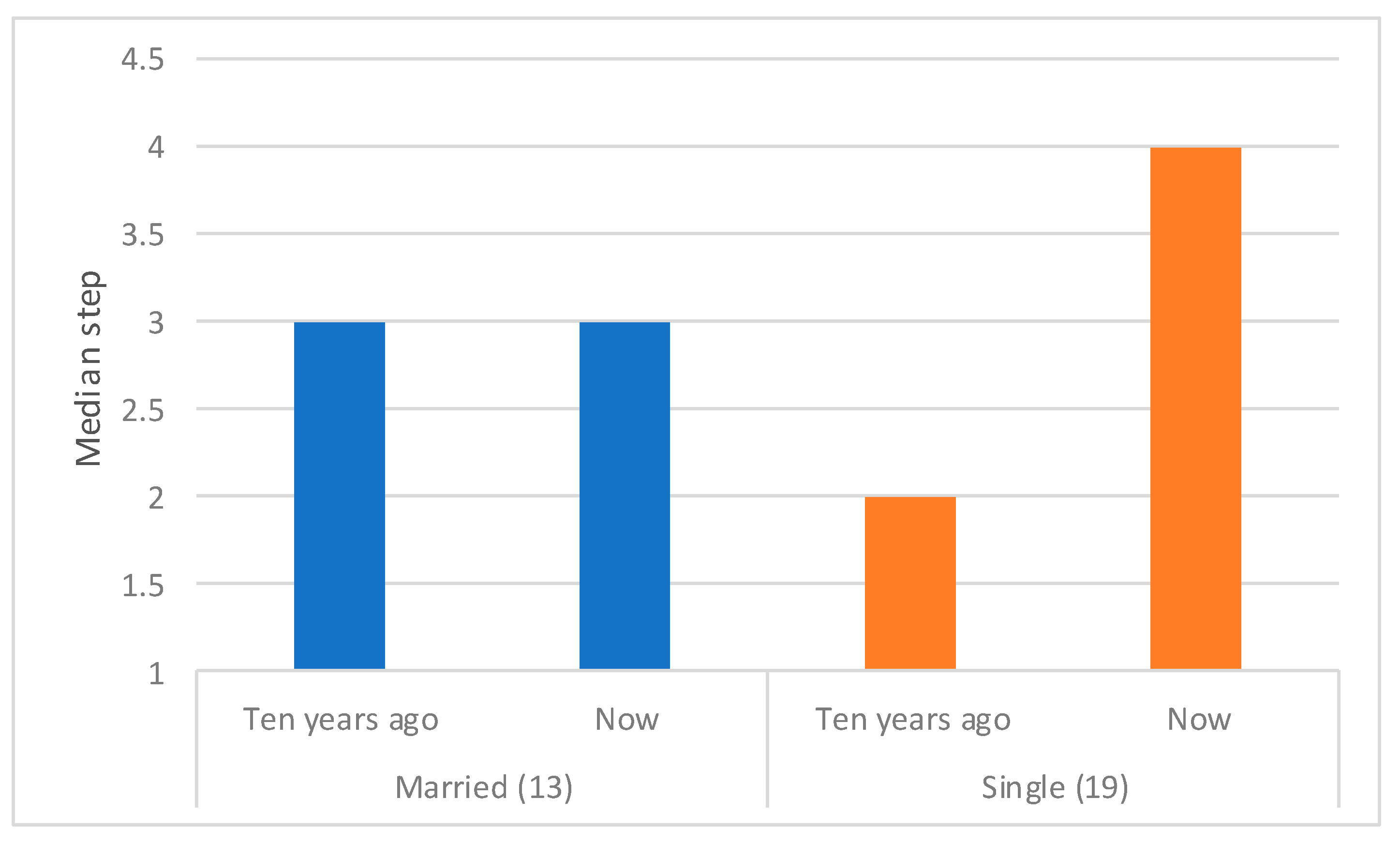
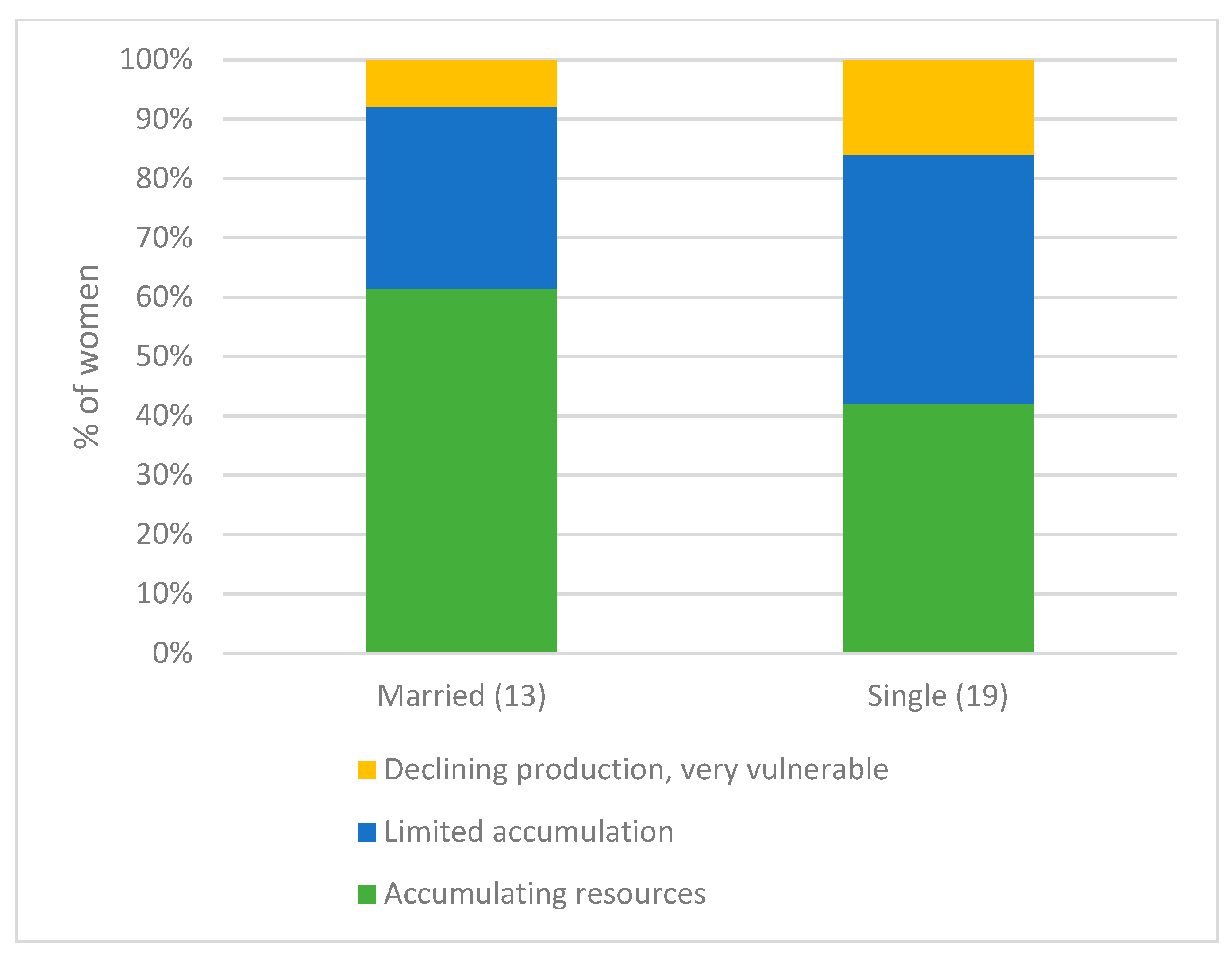
| Characteristics | Married (n = 13) | Single * (n = 19) |
|---|---|---|
| Age | 40 | 44 |
| Number of children | 6 | 5 |
| Age youngest child | 7 | 12 |
| Age oldest child | 22 | 26 |
| Polygamy (currently, or if single, in past) | 38% | 42% |
| Completed at least primary education | 38% | 21% |
| Cropland owner | 54% | 79% |
| Agricultural producer | 100% | 95% |
| Shop owner | 46% | 21% |
| Petty trader | 38% | 63% |
| Region, Village (Pseudonym) | Population Sampling Frame | Main Crops and Livestock | Social Characteristics |
|---|---|---|---|
| Amhara, Gobado | 10,800 Economic dynamism: High Gender gaps: Low | Wheat, fava bean, cattle, sheep, poultry | Ethnicity: 100% Amhara 30% FHH |
| Amhara, Badero | 4000 Economic dynamism: High Gender gaps: Low | Barley, fava bean, wheat, peas | Ethnicity: 100% Amhara 17% FHH |
| Oromia, Chala | 5652 Economic dynamism: High Gender gaps: High | Wheat, barley, peas, beans, oats, sesame, maize, chickpea, potato, carrot, beetroots, garlic, cabbage, onion. Cows, oxen, horse, donkey, sheep, and goats are common | Ethnicity: 75% Oromo, 20% Amhara, 5% Gurage. Religion: Orthodox Christian, Protestant, Muslim 25% FHH |
| Oromia, Akkela | 3344 Economic dynamism: High Gender gaps: High | Wheat, barley, peas, beans, oats, sesame, maize, chickpea, potato, carrot, beetroots, garlic, cabbage, onion. Cows, oxen, horse, donkey, sheep, and goats are common | Ethnicity: 80% Oromo, 20% Amhara Religion: Orthodox Christian, Protestant, Muslim 10% FHH |
| Oromia, Nebele | 6992 Economic dynamism: Low Gender gaps: High | Maize, wheat, barley, teff and sorghum, carrot, beetroots, and cabbage | Ethnicity: Oromo: 100% Religion: Muslim, Christian 5% FHH |
| Oromia, Oromila | 3000 Economic dynamism: Low Gender gaps: High | Maize, sorghum, wheat and teff, avocado, banana, cabbage, beet roots, potato, swiss chard, and carrot | Ethnicity: Oromo: 95%, Hadiya: 1%, Guraghe: 1% Religion: Majority Muslim 5% FHH |
| SNNPR, Hanawa | 2560 Economic dynamism: Low Gender gaps: High | Maize, inset, tomato, onion, carrot, potato, cabbage, khat, pepper | Ethnicity: Sidama: 99%, Welayita: 1% Religion: Protestant, Muslim 41% FHH |
| SNNPR, Wariso | 9000 Economic dynamism: Low Gender gaps: High | Maize, beans, enset, sorghum, teff, tomato, onion, carrot, potato, cabbage, khat, pepper | Ethnicity: Sidama: 100% Religion: Protestant, small number of Muslims 13% FHH |
| Type of Innovation | Married (13) | Single (19) |
|---|---|---|
| Improved wheat | 38% | 58% |
| Improved maize | 46% | 37% |
| Other crops | 77% | 74% |
| Agronomic practices | 62% | 68% |
| Other (e.g., animals) | 54% | 26% |
Publisher’s Note: MDPI stays neutral with regard to jurisdictional claims in published maps and institutional affiliations. |
© 2020 by the authors. Licensee MDPI, Basel, Switzerland. This article is an open access article distributed under the terms and conditions of the Creative Commons Attribution (CC BY) license (http://creativecommons.org/licenses/by/4.0/).
Share and Cite
Badstue, L.; Petesch, P.; Farnworth, C.R.; Roeven, L.; Hailemariam, M. Women Farmers and Agricultural Innovation: Marital Status and Normative Expectations in Rural Ethiopia. Sustainability 2020, 12, 9847. https://doi.org/10.3390/su12239847
Badstue L, Petesch P, Farnworth CR, Roeven L, Hailemariam M. Women Farmers and Agricultural Innovation: Marital Status and Normative Expectations in Rural Ethiopia. Sustainability. 2020; 12(23):9847. https://doi.org/10.3390/su12239847
Chicago/Turabian StyleBadstue, Lone, Patti Petesch, Cathy Rozel Farnworth, Lara Roeven, and Mahlet Hailemariam. 2020. "Women Farmers and Agricultural Innovation: Marital Status and Normative Expectations in Rural Ethiopia" Sustainability 12, no. 23: 9847. https://doi.org/10.3390/su12239847
APA StyleBadstue, L., Petesch, P., Farnworth, C. R., Roeven, L., & Hailemariam, M. (2020). Women Farmers and Agricultural Innovation: Marital Status and Normative Expectations in Rural Ethiopia. Sustainability, 12(23), 9847. https://doi.org/10.3390/su12239847





